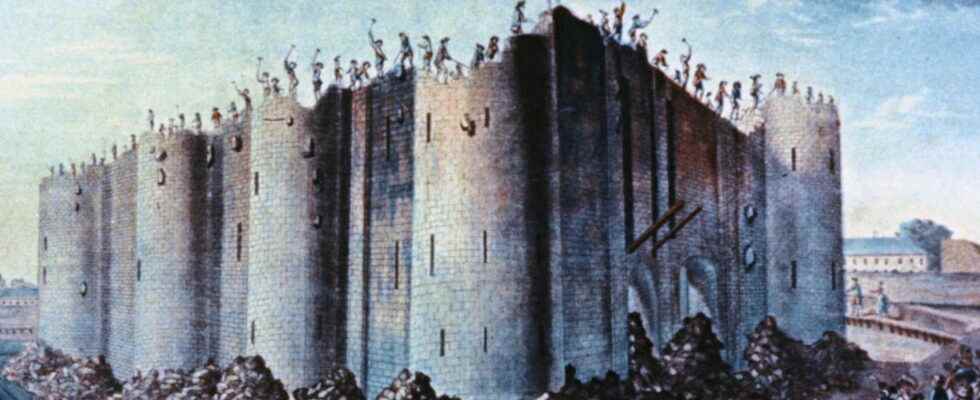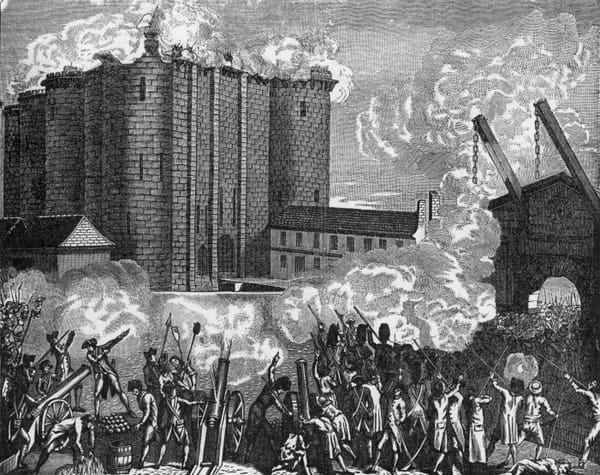On July 14, 1789, the storming of the Bastille, a fortress serving as a prison, was one of the triggers of the French Revolution. Having become a symbol, the date of July 14 was chosen to celebrate the national holiday.
The storming of the Bastille on July 14, 1789 was one of the events that precipitated the end of absolute monarchy in France. The Parisians are then exceeded as much by the rise in the price of basic foodstuffs like bread, as by the attitude of the king Louis XVI in front of the financial crisis. Having consented to the creation of a Constituent Assembly, the monarch nevertheless massed troops between Paris and Versailles. Then he removed the very popular and reformist Minister of Finance, Necker. On July 12, the crowd has already expressed its displeasure at the Tuileries. The demonstration was bloodily suppressed. The next day, the demonstrators are looking for the grain reserves. The revolt is organized, the rioters need ammunition. They looted the Invalides on July 14 in the morning and rushed towards the Bastille. They end up dropping this symbol of royal absolutism. The governor is beheaded, the French Revolution is working. A year later, the event was commemorated during the Fête de la Fédération and Louis XVI accepted the principle of constitutional monarchy. But, the king multiplies the missteps, he is guillotined in 1793.
The States General opened in May 1789 in an uncertain social and monetary context. France is on the verge of bankruptcy and famine is raging, while the Court is accused of leading a grand train. At the end of the Oath of the Tennis Court, the National Assembly swears to establish a new Constitution for France. King Louis XVI must recognize the power of the deputies. In great secrecy, he nevertheless gathers troops at the gates of Paris. Alerted, the National Assembly asks for their dispersion. The king refuses and dismisses Necker, his finance minister, a supporter of new reforms. Revealed on July 11, the news acts as a quick spark to ignite the popular fire. Camille Desmoulins incites the Parisian rioters to overthrow the royal administration. On the morning of July 14, they seized guns from the Invalides, but did not have powder. They decide to go to the Bastille fortress to get some.
Following the riots of July 12 and 13, 1789, grain reserves were looted in the capital. The French guard refuses to obey the king. An insurrectionary committee is organized at the Hôtel de Ville. the July 14, 1789 in the morning, the rioters who looted the Invalides are looking for ammunition. Located to the east of Paris, the Bastille was then a state prison. Placed under the command of Governor de Launay, it was attacked by rioters. The crowd first attends the negotiations which drag on. In the early afternoon, an explosion rang out. The insurgents, believing themselves to be attacked, give the storming of the Bastille. Around 5 p.m., July 14, 1789, de Launay capitulated. The Bastille falls into the hands of the attackers who massacre the defenders of the building.
Upon his arrival on the throne in 1774, Louis XVI inherited a ruined kingdom. He tried, in vain, several financial reforms. In 1789, before the storming of the Bastille, he engaged in an ambivalent game with the deputies of the States General. He accepts the conditions of their Assembly, but he brings in armed troops in secret and dismisses Minister Jacques Necker. The king had gone hunting in Marly on July 14. He did not learn of the storming of the Bastille until the morning of July 15. He had the troops he had posted between Versailles and Paris withdrawn, but too late. When he addresses the National Assembly that day, he recognizes the legitimacy of the latter. On July 16, Jacques Necker is back in office. On July 17, Louis XVI went to the Hôtel de Ville in Paris, the epicenter of the revolt. Later, the monarch will be forced to agree to become a constitutional king. In 1791, when he wanted to rally the support of the monarchies of Europe, he tried to flee France, but he was arrested in Varennes. After his trial, Louis XVI was guillotined on January 21, 1793.
The storming of the Bastille on July 14, 1789 is often perceived as the beginning of the French Revolution, even if it officially began with the holding of the Estates General on May 5, 1789. The storming of the Bastille remains one of the events of this period which will have multiple consequences for France. First of all, on July 14, 1789, the third estate intervened for the first time in the Revolution and took the measure of its power. Then, three weeks after the storming of the Bastille, the National Constituent Assembly proclaimed the end of the feudal system and its privileges. Indeed, the revolt spread to the countryside where the peasants attacked the lords. But the assembly does not stop there. On August 26, 1789, she voted for the Declaration of the Rights of Man and of the Citizen. Freedom is obtained by all.
Under the aegis of Lafayettea big Federation Party is organized a year after the storming of the Bastille to commemorate the event. It takes place at the Champ-de-Mars and the crowd throngs there because historians mention nearly 400,000 people present. Louis XVI then officially took the oath before the Nation, made up of the people, the deputies, the representatives of the regions and hundreds of priests who wore a tricolor cassock. By becoming a constitutional monarch, Louis XVI is no longer king of France, but king of all French people. A new feast of the Federation will be celebrated in 1792, without the fervor of this one. It was not until 1880 that July 14 became a national holiday in France.
The Bastille faces working-class neighborhoods which suffered the consequences of the catastrophic harvests of 1788. This fortress, built in the Middle Ages, symbolizes the arbitrariness of royal power. A letter of cachet signed by the king is enough to send any individual to the dungeon. The resumption of power by the people is sealed by the beheading of Governor de Launay. His head is brandished on the pike of a bayonet facing the crowd. Another symbol of this new era, the blue, white, red tricolor cockade. It was handed over to the king on July 17 at the Hôtel de Ville in Paris and became the symbol of the French Revolution.
- July 14, 1789 – Storming of the Bastille
- When the rioters arrive en masse at the Bastille to express their anger against the king who is unable to pull the kingdom out of disaster, negotiations begin. The prisoners are few, the fortress has less than twenty guns and it is protected by a small garrison. The rioters, who looted the Invalides to find weapons, seem, at first, to want gunpowder, but the exchanges escalate and the situation degenerates.
- July 6, 1880 – July 14 declared a national holiday
- On July 14, 1790, the Fête de la Fédération takes place, which commemorates the storming of the Bastille and the end of the absolute monarchy. It was not until July 6, 1880 and Raspail’s bill that July 14 became the national holiday of all French people. It refers to 1789 for the Bastille and to 1790 which marks the union of the Nation.

